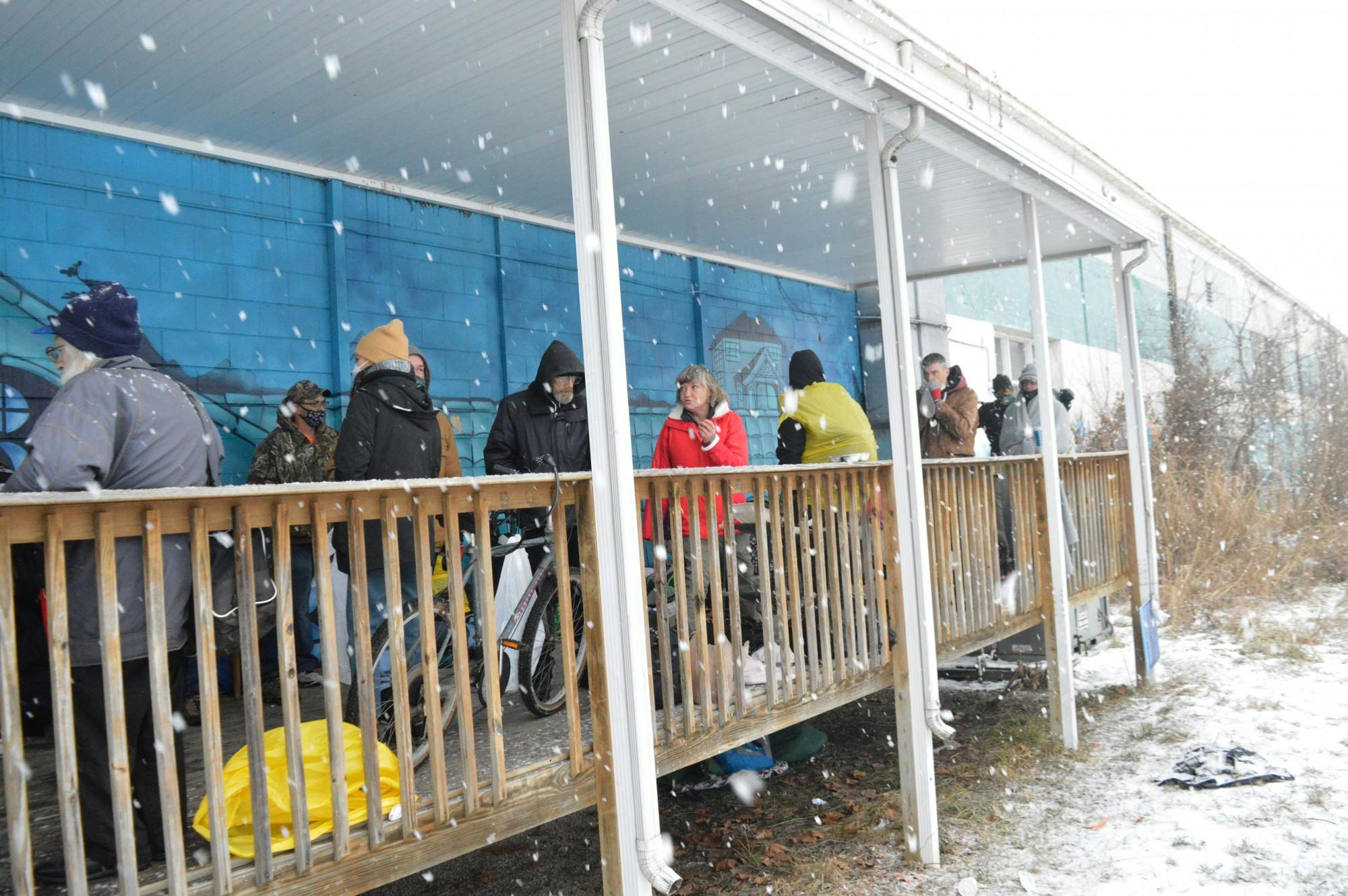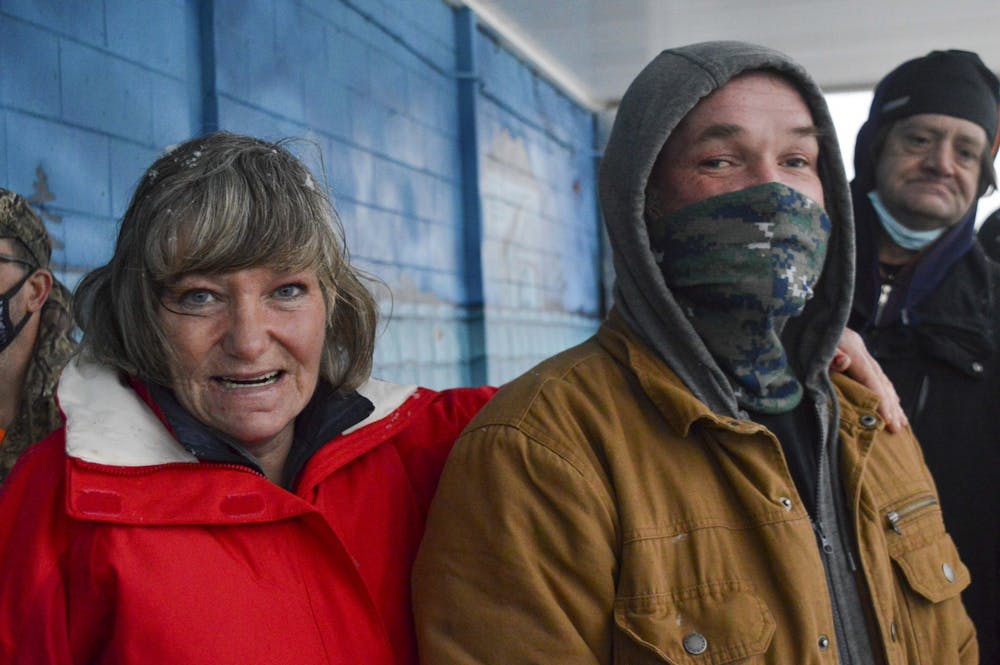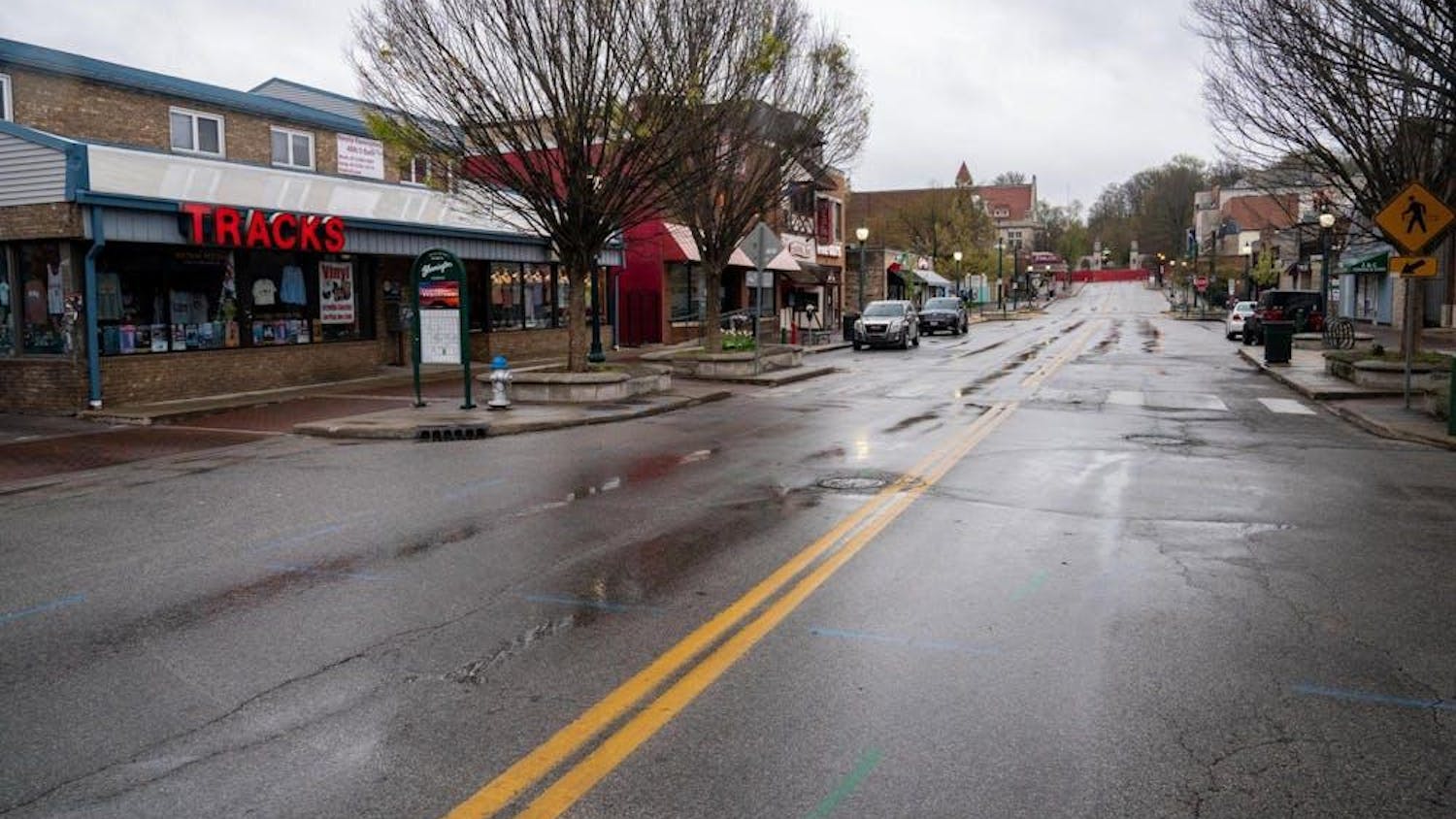As he sat under the awning of A Friend’s Place, an overnight shelter, and leaned back against the wooden chair he was sitting in, Randy Haler sighed. In the freezing January air, he could see his own breath.
Haler, 68, has been experiencing homelessness for nine months. But when he was in his 20s, he walked the same sidewalks that IU students walk now. From 1972 to 1976, Haler resembled many current students in the O’Neill School of Public and Environmental Affairs. He was upset with the way corporations and human beings treat the planet. He hoped to study environmental law after he graduated.
In 1974, he was in a car accident that bruised his brain stem. Since then, he has dealt with seizures and memory loss.
Haler adjusted his gloves and pulled his hat lower over his head as snow continued to flutter down from the sky. He said that since his wife died, just a year before their 25th anniversary, it’s been difficult to do anything. But he's trying to find housing right now using the Social Security Benefit payments he receives.
“I have to be patient, that’s all there is to it,” Haler said. “Because I can get myself screwed. The check doesn’t go too far.”
Bloomington's unhoused population faces challenges from few sources of stable or affordable shelters to hostility generated by negative stereotypes. Seven members of the unhoused community told the Indiana Daily Student that they want Bloomington residents to view them as human beings, just trying to survive.

Related: [Bloomington City Council members drafting ordinance to better protect homeless camps]
Hostility toward the unhoused population
Harry Collins, the founder of Bloomington Homeless Coalition, has experienced homelessness on and off for about 16 years. He’s lived in Bloomington for his entire life, and he says conditions for the unhoused population have only gotten worse over the years.
Collins said from the moment he wakes up to the moment he goes to sleep, he is doing work for the Bloomington Homeless Coalition, whether he’s giving interviews or helping others in the unhoused community find resources. He said he wished that those who had never experienced homelessness before realized that the unhoused, too, are human beings. All he’s asking for is respect, he said.
Related: [150 gather to protest Bloomington’s treatment of homeless community, march to mayor’s house]
In 2017, a petition on Change.org addressed the unhoused population in People’s Park, stating, “Over the past several years, the homeless have decided to make this park their home, starting fights, doing drugs, setting one another's belongings on fire, and causing raucous 24/7.”
As a result of increased police presence, the unhoused population decided to leave People’s Park, dispersing across Kirkwood, abandoned buildings and other places.
Collins said while there are people in the unhoused community dealing with addiction, the assumption that none of them are trying to get better is unfair. He also said there are people who don’t use drugs or drink at all.
He said negative attitudes toward the unhoused are nothing new. People have told him those experiencing homelessness should go to hell.
Candance Goffinet, 50, said she has struggled with opioid addiction, but is working on getting clean. In 2007, Goffinet said she was hit by a train and lost her right arm. She said doctors prescribed her painkillers, but when those stopped numbing her pain, she became addicted to heroin. She is now on Suboxone, a drug used to treat opioid addiction. Goffinet said she still experiences the pain 14 years later, but is working to stop using.
“I got phantom limb pain, all kinds of pain,” she said. “I mean, I got hit by a train. I lost my arm. It was awful.”
Goffinet said many people look down on the unhoused, and people have treated her differently when they realize she is experiencing homelessness. Similarly, Aries, who was evicted from Seminary Park on Jan. 14, said many people look down on him. It’s demoralizing, he said.
“Have you ever had an equal spit at you, laugh at you, call you disgusting, tell you what to do with your life?” he asked.
Related: [City employees, Bloomington police dismantle Seminary Park homeless camp Thursday night]
Aries said he feels like many in the unhoused population have been broken down and are afraid to stand up for themselves. Beacon, an organization that works to serve those in poverty and experiencing homelessness, estimated that around 38 people were staying at Seminary Square Park before the January eviction.
By the time the park was evicted on Jan. 14, only two people remained. Many in the unhoused population, fearing arrest or escalation, left before BPD arrived at Seminary Park that night, Aries said.
“They’re so easily dissuaded through a life of pain, angst, anguish and being stomped down,” he said. “Look at this. They all left,” Aries said, pointing around Seminary Square Park, where activists and police officers lingered but most unhoused people had fled.
Limited housing options
In five weeks, encampments at Seminary Square Park have been evicted twice. The first eviction took place on Dec. 9, when BPD and city employees cleared tents and belongings out of the park.
During the second eviction, Aries looked upon what had been his home for two weeks. Scattered blankets, plastic tarps and bicycles sat under a light mist in near-freezing weather that would reach below freezing later that night. For some people, the items scattered across Seminary Square Park were all they owned, Aries said.
“Take all of that, I mean all of that, and that’s almost what a normal person has in one apartment,” he said, motioning at the items on the ground.
Felicia Johnson, who is also experiencing homelessness, said she’s watched more apartment complexes spring up for college students. She said she wishes that there would be a focus on creating affordable housing for those with a limited income.
“Not even to be selfish, but we deserve to have a life too,” Johnson said. “We deserve to live. We deserve to be warm.”
Collins said the fact that affordable motels have closed and been replaced by apartment complexes for students has forced some in the unhoused population into city parks, making them more visible to the public. He said this has generated hostility from some in the Bloomington community.
“They don't want to see us? Then stop destroying the places that we can use,” Collins said.
In 2015, Southern Winds Inn closed, leaving 36 low-income households with no housing, according to the Herald-Times. Residents of Southern Winds Inn said it was one of the only locations where people with barriers to housing, such as poor credit histories or financial issues, could find shelter.
Then, Motel 6 closed down in 2020, to be replaced by a 750-bed student apartment complex. Motel 6 was one of two hotels in Bloomington that accepted housing vouchers, Perry Township Trustee Dan Combs told the Herald-Times.
For some people in the unhoused community, the rules and restrictions of homeless shelters make it difficult to stay there. Goffinet is staying at A Friend’s Place. She has a boyfriend of 14 years but said she isn’t allowed to sleep with him at night because the shelter is separated by gender. She said the shelter also requires people to be in bed by 8 p.m.
“I’m 50 years old,” she said. “I’d like to be treated like an adult.”
Beacon found pet ownership, separation of couples, religion, distance, shelter rules and storage were some of the reasons that people might not stay at shelters. As a result, Beacon opened a new shelter at Switchyard Park that resolved these issues.
Related: [New homeless shelter opens by Switchyard Park, has already accommodated dozens]
On top of those issues, Johnson said COVID-19 has become a threat to those staying in communal spaces, like shelters. Johnson had to isolate for a week because her roommate tested positive for COVID-19. Payne, her partner, also had to isolate for a week, forcing him to call off of work.
Collins said a lot of people experiencing homelessness want to have jobs and provide for their own housing, but it can be difficult to secure a job when they’re living in a tent.
Aries, who holds a job right now, said he believes many employers don’t want to hire those from the unhoused community because of the stigma.
Aries works with heavy machinery and gets grease and dirt on his clothes, but he said his employer asked him to get a haircut and new clothes. The ends of his grey hoodie are stained in black grease.
“What's gonna happen when I buy a $30 hoodie just so I can look nice and fucking it's black?” Aries said. “The next day, I have to buy another one.”
And jobs aren’t a fix-all solution, anyway.
Payne is currently working at McDonald’s, but he said he doesn’t make enough money to pay rent for an apartment. Payne said rent for an apartment is hundreds of dollars that he can’t afford.
In 2015, a study from Tikijian Associates estimated the average rent in Bloomington was $893, higher than in surrounding areas. Payne’s paychecks vary based on the hours he works, but he said some have been less than $150 after taxes.
Freezing temperatures endanger unhoused people
Without a source of shelter or a job that provides enough for rent, some unhoused people have found themselves stuck in the cold weather.
Dying in the cold isn’t a hypothetical concern for those in the unhoused community. JT, a 51-year-old Bloomington resident, died in Seminary Park on Christmas Eve. JT’s death came after his tent was taken away in the December eviction, BHC board member Marc Teller told the IDS in January. Teller said he held the city responsible for JT’s death.
Johnson said that JT’s death deeply affected her. Like many in the unhoused community, she considered him family. JT isn’t the first friend she has lost.
“A lot of our friends have died,” Payne said.
Related: [Community grieving, scared after two people experiencing homelessness die within two days]
Freezing temperatures are a concern for everyone in the unhoused population, even for some in shelters. Payne and three other unhoused people said there hasn’t been heating inside A Friend’s Place for weeks. Payne said he wears three layers of clothing when he sleeps at night.
Lenora Binkley, Director of Shelter Programs at A Friend’s Place, denied the allegation and said there are multiple functioning heaters throughout the shelter.

Rick Moser, 61, has been experiencing homelessness off and on for 15 years. He said he doesn’t have anywhere to stay during the day. Although he goes to the new overnight shelter at Switchyard Park at 9 p.m. when it opens, he has to leave the shelter by 7 a.m. This means for 14 hours a day, Moser is outside in often-freezing temperatures.
Moser, who said he has owned two homes at separate points in his life, never expected to experience homelessness.
He does everything he can to stay warm during the day. Recently, Moser has been going to the Community Kitchen for hot meals. Sometimes he rides on city buses until he’s kicked off.
He pointed down at the snow-encrusted boots on his feet that he had just gotten a few weeks ago, one of his key defenses against cold temperatures. For two years, he had owned the same brand of boots and said his feet had never gotten cold or wet.
But on the night of Jan. 27, as he stood in freezing temperatures under the awning of A Friend’s Place to protect himself from the flurry of snow, he said his feet grew cold.
He looked around at the other people huddled on the porch waiting for the shelter to open. Many of them were wearing tennis shoes.
“I don’t see how they can even take it,” he said. “Because once my feet get frozen, I might as well lay down and die.”
Correction: A previous version of this story misstated the name of the O’Neill School of Public and Environmental Affairs.




